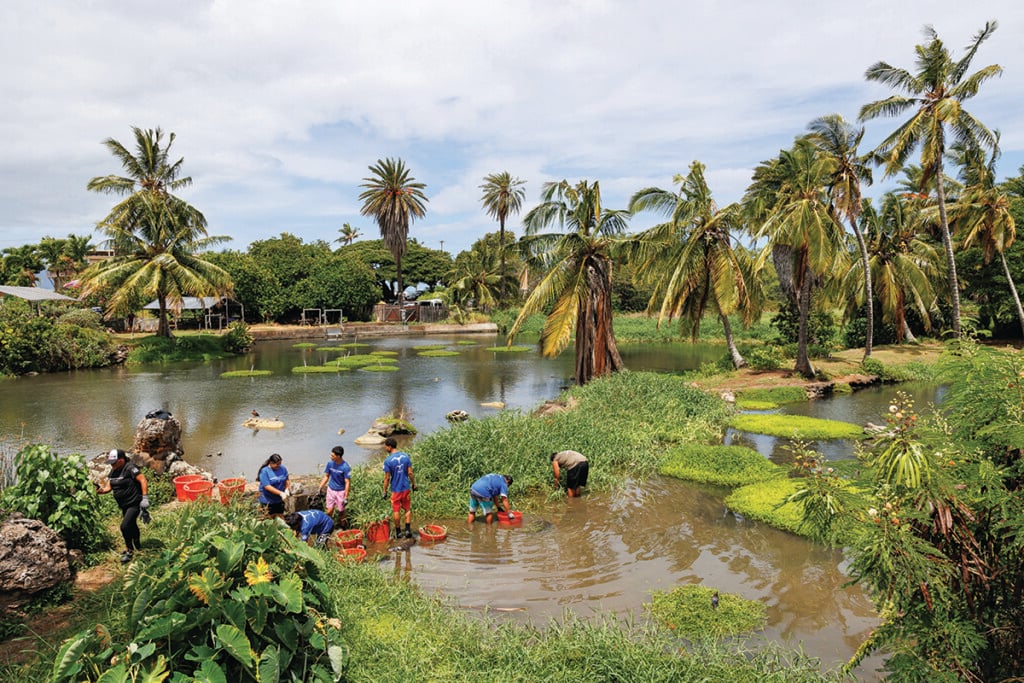Q&A: Inside the 11-year research process of rediscovering Hawaiian rain names

Like the Islands themselves, olelo Hawaii (Hawaiian language) is a living part of the native culture. This relationship between land and language can best be displayed by the number of Hawaiian words and terms that exist for rain: there are more than 200. In a new book, Hanau Ka Ua—Hawaiian Rain Names, author Collette Leimomi Akana, with her daughter and co-researcher Kiele Gonzalez, compile the most comprehensive record. “Whenever we’d find a new rain name, it was like finding a diamond,” Akana says of the 11-year research process, sourcing Hawaiian chants, songs and stories passed down through generations.

terms and phrases in the Hawaiian language
for rain. Cover courtesy Kamehameha Publishing
What revelations while researching and collecting the rain names surprised you?
Collette Akana: Just that they came in a great variety. Some have plant names embedded within their names, some are adjectives. I definitely enjoyed collecting the moolelo (stories) and mele (songs) behind many of them.
Kiele Gonzalez: Some of them are also incorporated into olelo noeau (proverbs). Our kupuna (ancestors) were so observant of their environment and just highly attuned with their surroundings. They were able to recognize and identify these subtle differences between rains, the patterns they’d fall in, the way they blew, what time they’d come, their duration, their scent—all of that was part of what would go into their names—and it’s all reaffirmed in modern climatology. Scientists consider the rain patterns and activity here to be one of the most complex and we know our kūpuna recognized that by tracking those differences and naming them separately.
Do either of you have a favorite rain?
CA: I found this rain name, Alanilehua, and I thought it had to be a mistake, with alani (orange), the adjective, before lehua (ohia tree flower). [In olelo Hawaii, adjectives follow nouns.] I left it aside, and then I found another source referring to the Alanilehua. It was deeply descriptive and had very specific information about this rain that occurs in Puna, how it comes from Hilo, and I thought, OK, I’m wrong! That’s my favorite because I didn’t think it was a name at first.
KG: Alani doesn’t refer to the color, maybe more refers to lani, the heavens. When we could get a meaning or interpretation of the rain name or felt confident about ours, we included it in the book.
CA: I also like the Kanilehua. There are different definitions, one of which is the chattering of the birds. But the Pukui-Elbert Hawaiian Dictionary shows it literally means, “[rain that] lehua flowers drink.” From that, we’re able to get a story about its definition. We don’t have a mo‘olelo on every rain name, so it’s great when we can include one.
KG: And it could refer more figuratively to gossip. One of my favorites is the Haleuole rain, which means “without toilet paper” or to not wipe. In other words, it’s a rain that comes so suddenly you don’t have time to wipe after yourself. I like the humor in that. Potty humor, I guess, but it’s so colorful, right? The names our kupuna gave these rains, some express such aloha, such poetry, but also humor. I think that’s so characteristic of Hawaiians, our people.
What was most challenging about compiling this book?
Akana: Kiele tells me to stop, ‘Mom, we got to put it out!’ (Laughs) The more we find, the more checking up on one rain leads to another wind name or an additional source, some of which are so juicy.
Gonzalez: Just to clarify, as many times as I’d say stop, I’d turn around and say, “Okay, put it in.” I would always give in until the final publication date. (Laughs) There are so many times we unstopped ourselves. My mom found hundreds of sources, hundreds of different voices from a long time ago. Just trying to understand the context these rains are used in and the manao (intention) of each author or composer, trying to understand what they meant.
What do you hope readers get out of rediscovering these rain names?
CA: A connection to our kupuna and aina (land), and to really feel it. Not just, “I come from Aiea, but I come from Aiea and the Waahila rain.” To say, “I know my land,” and that we hoomau, to continue, what our kupuna knew. To be kilo, more observant, of what’s happening around us. “What’s the weather like? Where’s the wind coming from? What does that all mean?” And if we notice there’s something pilikia, something off, is there something we can do about it? Because the more we connect to the aina, the more we take an interest in malama aina, to care for the land.
Hanau Ka Ua—Hawaiian Rain Names, $30, available for purchase here.


